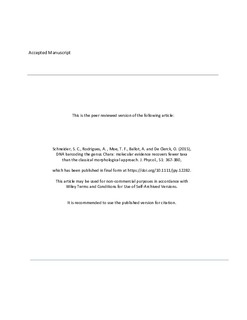| dc.description.abstract | Charophytes (Charales) are benthic algae with a complex morphology. They are vulnerable to ecosystem changes, such as eutrophication, and are red‐listed in many countries. Accurate identification of Chara species is critical for understanding their diversity and for documenting changes in species distribution. Species delineation is, however, complicated, because of high phenotypic plasticity. We used barcodes of the ITS2, matK and rbcL regions to test if the distribution of barcode haplotypes among individuals is consistent with species boundaries as they are currently understood. The study included freshly collected and herbarium material of 91 specimens from 10 European countries, Canada and Argentina. Results showed that herbarium specimens are useful as a source of material for genetic analyses for aquatic plants like Chara. rbcL and matK had highest sequence recoverability, but rbcL had a somewhat lower discriminatory power than ITS2 and matK. The tree resulting from the concatenated data matrix grouped the samples into six main groups contrary to a traditional morphological approach that consisted of 14 different taxa. A large unresolved group consisted of C. intermedia, C. hispida, C. horrida, C. baltica, C. polyacantha, C. rudis, C. aculeolata, and C. corfuensis. A second unresolved group consisted of C. virgata and C. strigosa. The taxa within each of the unresolved groups shared identical barcode sequences on the 977 positions of the concatenated data matrix. The morphological differences of taxa within both unresolved groups include the number and length of spine cells, stipulodes, and bract cells. We suggest that these morphological traits have less taxonomic relevance than hitherto assumed. | nb_NO |
